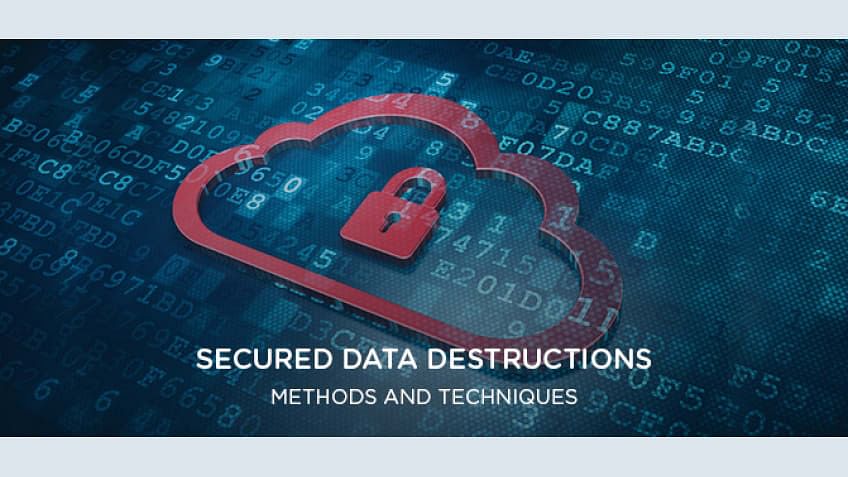Understanding the Role of Data Destruction in Strengthening Cyber Security Defenses
Understanding the Role of Data Destruction in Strengthening Cyber Security Defenses
Blog Article
The Significance of Effective Information Damage Practices in Safeguarding Sensitive Information and Ensuring Computer System Protection
In an age where data breaches are significantly typical, the value of reliable information destruction techniques can not be overemphasized. Executing robust information damage approaches not just reduces these risks however additionally straightens with lawful compliance demands, guaranteeing that companies support their online reputation and foster client depend on.
Understanding Data Destruction
Understanding data devastation is important in today's electronic landscape, where delicate info can quickly be compromised. Reliable data devastation involves not just removing documents yet making sure that information is irretrievable via thorough techniques. This procedure is necessary for companies that take care of private client information, intellectual property, or internal documents, as any kind of violation can result in severe economic and reputational effects.
Information devastation incorporates various strategies, consisting of shredding physical media, degaussing magnetic storage devices, and employing software-based remedies that overwrite data multiple times. Each technique offers a particular function and needs to straighten with the sensitivity of the information being disposed of. As an example, physical destruction is typically favored for disk drives having extremely private data, while software application methods may be adequate for less sensitive information.
Furthermore, sticking to industry requirements and laws, such as the General Data Security Regulation (GDPR) or the Medical Insurance Mobility and Accountability Act (HIPAA), is critical for compliance and to alleviate lawful threats. Organizations must create a durable information destruction plan, train employees on finest practices, and frequently audit their treatments to guarantee that all sensitive information is disposed of securely and successfully.
Dangers of Inadequate Practices
Insufficient information damage methods reveal companies to significant threats that can have far-reaching effects. When delicate details is not correctly gotten rid of, it stays susceptible to unapproved access, which can lead to information violations and identity burglary. Such cases not only jeopardize the safety of individuals but also tarnish the company's reputation, resulting in a loss of consumer depend on and prospective economic effects.
Moreover, regulatory compliance is significantly strict in many industries. Failure to comply with information destruction policies can cause significant penalties and lawsuits against organizations. These fines can draw away and stress economic resources attention from core business procedures.
On top of that, the misuse of residual information can lead to copyright theft or company reconnaissance, jeopardizing affordable benefits (data destruction). The influence of inadequate information damage prolongs past instant monetary losses; it can additionally cause lasting damage to brand name honesty and market position

Organizations must acknowledge that data protection is not solely about avoiding violations; it also encompasses the liable administration of data throughout its lifecycle. Neglecting reliable information damage methods can have devastating implications, emphasizing the need for robust measures to alleviate these risks.
Best Practices for Information Devastation
Implementing efficient information destruction methods is essential for safeguarding delicate details and keeping conformity with governing criteria. Organizations must adopt a multi-faceted technique to guarantee that information is irretrievable, therefore stopping unapproved gain access to and possible violations.
First, data must be classified based upon level of sensitivity, allowing companies to apply appropriate devastation methods tailored to the level of threat. For electronic information, utilizing software-based data-wiping tools that follow market criteria can efficiently overwrite existing data. Physical devastation techniques, such as shredding or degaussing, are vital for gadgets that keep delicate info, making Click This Link certain complete elimination.
Establishing a clear data retention policy is crucial, describing exactly how long different kinds of info should be retained before devastation. Routine audits of information storage space systems are additionally required to identify obsolete or unneeded information requiring elimination.
Moreover, training workers on the significance of information devastation and the specific protocols to comply with fosters a culture of security within the organization. Finally, preserving documents of information damage refines supplies liability and sustains conformity with interior plans and exterior policies. By sticking to these best methods, companies can substantially alleviate the threats connected with data exposure.
Legal and Compliance Factors To Consider

Failing to follow these guidelines can lead to extreme charges, consisting of substantial see this here fines and reputational damage. Organizations needs to implement a durable information devastation policy that lines up with these lawful structures and supplies clear standards on the appropriate approaches of information disposal, whether physical shredding or digital cleaning.
Furthermore, preserving documentation of information damage activities is necessary for demonstrating conformity during audits or examinations. By prioritizing legal and compliance considerations, organizations can enhance their data safety pose and foster trust fund with clients and stakeholders, ultimately contributing to a more safe and secure data administration atmosphere.
Advantages of Effective Information Devastation
Effective information destruction practices extend beyond simple conformity; they supply considerable benefits to companies that prioritize them. By ensuring that sensitive information is irretrievably damaged, organizations mitigate the danger of information violations and the prospective economic effects connected with them. This aggressive method not only safeguards against unapproved gain access to yet additionally enhances the total reliability of the company in the eyes of stakeholders and clients.
Implementing durable information devastation techniques, such as physical destruction of storage space gadgets or sophisticated information wiping techniques, adds to the fortifying of an organization's cybersecurity posture. data destruction. It lowers the chance of copyright theft and shields exclusive info, thereby keeping a competitive edge in the market

Final Thought
In verdict, efficient information damage practices are vital for protecting sensitive information and boosting total computer system protection. Eventually, a commitment to robust data devastation methods promotes a culture of duty, therefore enhancing an organization's cybersecurity stance and preserving client trust.

Report this page